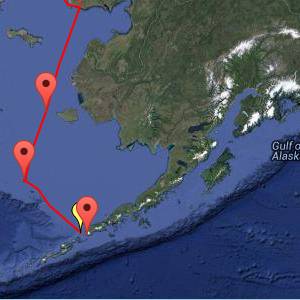
SV Traversay III - North West passage/Unimak Pass
The weather forecast for the Unimak Pass section of the Aleutians was, we are told, typical for this time of year. Later in the year, it gets worse.
PKZ170-210300-
EASTERN ALEUTIANS CAPE SARICHEF TO NIKOLSKI
400 AM AKDT FRI SEP 20 2013
.STORM WARNING TONIGHT...
TODAY...S WIND 20 KT BECOMING SW 45 KT BY EARLY AFTERNOON. SEAS
10 FT BUILDING TO 16 FT LATE THIS AFTERNOON. PATCHY FOG. RAIN.
TONIGHT...W WIND 50 KT BECOMING NW 35 KT TOWARD MORNING. SEAS 23 FT.
PATCHY FOG.
SAT...NW WIND 35 KT. SEAS 15 FT. PATCHY FOG.
SAT NIGHT...NW WIND 35 KT. SEAS 12 FT.
SUN...W WIND 20 KT. SEAS 8 FT.
MON...SW WIND 20 KT. SEAS 8 FT.
TUE...W WIND 20 KT. SEAS 12 FT.
Thus as we approached St. Paul Island, we threw in a bit of a delay at anchor in order to let the worst pass as Mary Anne said in the previous blog. The dreary morning of our arrival at St. Paul was followed by a brief treat as we left 10 hours later: the rain had diminished enough that we could see the shores were carpeted with fur seals! These animals used to be hunted here but now it is forbidden to even go ashore on the rookery beaches during the breeding season. We had not seen such a spectacle since South Georgia.
Our furnace has failed. This is not the disaster in the "warmth" of the Aleutians that it would have been in the frigid chill of the high arctic .. and we can always run an inconvenient electric fan heater (but only when we don't have the 12 ft waves we're currently experiencing).
The failed part is only worth a few dollars. So why wasn't it aboard? Well it was!
After giving faithful service for years, the glow-pin igniter failed further north when it was REALLY cold. I replaced it with a spare and we were warm as toast in minutes. The new part failed, however, after a few more weeks of use.
So why don't we stop a while and just get things fixed? We HAVE fixed many things on this trip from England either in port or with on-board spares and materials. This sort of voyage gives hard usage to the boat AND the people. But non-essential repairs? Further north, a delay of days might mean stopping for a 9 to 11 month winter and not being able to live on the boat which is, after all, our home. As we emerge south of Unimak pass, it is finally possible to stop for repairs but because of the rapidly worsening autumn weather on the offshore North Pacific, such a delay will almost certainly prevent our timely arrival in Victoria via the offshore North Pacific. These realities of small boat sailing are so foreign to modern life that it is difficult for the uninitiated to understand how a few days stopped can mean as much as a one year delay. As an aside, we met a Dutch sailor in Colonia, Uruguay whose one month delay for a mast repair cost him a year because he missed the "weather window" for a high latitude voyage he was planning.
As it is, the current forecasts indicate abysmal weather on the route to Juan de Fuca Strait. This starts a couple of days after our Unimak passage and extends for a week and beyond as a succession of weather systems move from the Aleutians out across the Gulf of Alaska. We only once in our New Zealand to Chile voyage saw such deep lows, strong winds and high waves - and in that storm Mary Anne was injured and our boat was damaged.
It is true that we left Washington State in November, 2004 into a wintry North Pacific. What is different? When southbound from these latitudes, you can deal with the close of a single weather system and perhaps the rapidly weakening southern reaches of another. In a few days, you are so far south that autumn and winter can't touch you. The forecasts stretch out that far with some reliability. When eastbound, on the other hand, you do not escape this stormy stretch of ocean until almost two weeks later as you arrive in port.
So what now? At least here there are options. The coast can be sailed on the rare good days hidden in on the bad] at least as far as Prince William Sound. We might winter at Kodiak, get our boat back in the top shape she was in before leaving England, and set out again in the spring. Or, if on arrival in Kodiak a sufficient length of settled weather were available, we might set out on the there] much shorter crossing to the inside passage and make our way south along that sheltered route.
Oh, and yes, our weather southeast bound in the Bering Sea on Saturday was just as bad with waves just as high as that forecast predicted.
SV Traversay is a 43 steel sloop sailed by Mary Anne and Larry and they are sailing through the North West passage from east to west.
At 22/09/2013 22:53 (utc) our position was 54°23.04'N 164°50.33'W

